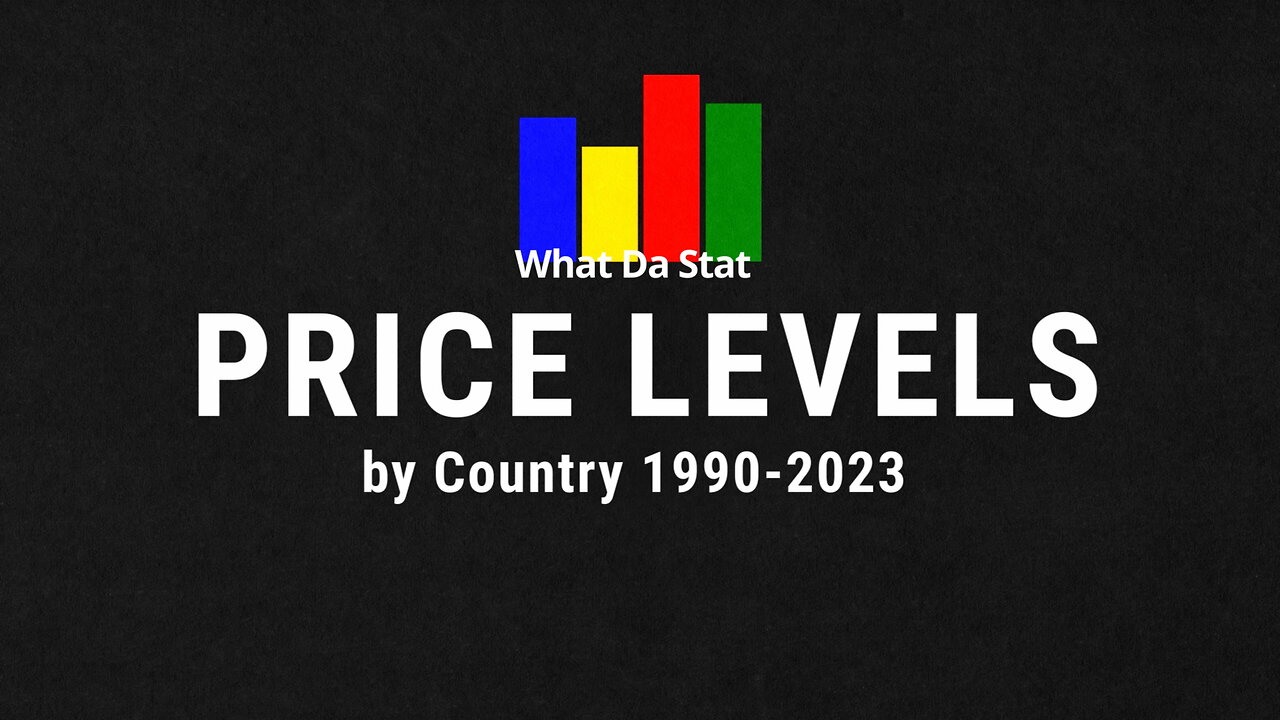Premium Only Content

Countries Price Levels Compared to USA 1990-2023
This bar chart race compares price levels on goods and services in countries/territories compared to United States of America (USA = 0), from 1990 to 2023, highest and lowest.
* The price levels (in percentage) are calculated as:
(Price level ratio of PPP conversion factor (GDP) to market exchange rate) - 1 x 100
The "Price level ratio of PPP conversion factor (GDP) to market exchange rate" is a concept used to compare the cost of goods and services across different countries.
Here’s a simple breakdown:
PPP (Purchasing Power Parity) Conversion Factor: This is a way of adjusting money so that you can compare what a certain amount of money can buy in different countries. For example, $10 might buy more things in India than in the United States. The PPP conversion factor adjusts for these differences.
PPP Conversion Factor (GDP): This specifically refers to the adjustment made to a country's GDP to reflect the true purchasing power of its currency. It tells us how much of the country's GDP is needed to buy the same basket of goods and services that you could buy with the GDP of another country, after adjusting for price differences.
Market Exchange Rate: This is the rate at which you can exchange one country's currency for another. For instance, if 1 US dollar can be exchanged for 100 Japanese yen, that's the market exchange rate.
Price Level Ratio: This ratio compares the PPP conversion factor to the market exchange rate.
If the ratio is 1, it means that the market exchange rate perfectly reflects the difference in prices between two countries.
If the ratio is greater than 1, it means that things are generally more expensive in that country when using the market exchange rate compared to what the PPP suggests.
If the ratio is less than 1, it means that things are generally cheaper in that country when using the market exchange rate compared to what the PPP suggests.
In essence: This ratio helps to understand whether a country’s currency is overvalued or undervalued in terms of its purchasing power. If the price level ratio is high, the country might seem expensive when using the market exchange rate, while a low ratio might indicate that the country is cheaper.
No data: American Samoa, Cuba, Channel Islands, Gibraltar, Guam, Isle of Man, Northern Mariana Islands, New Caledonia, North Korea, French Polynesia, British Virgin Islands, Cuba, North Korea, Lichtenstein, Monaco, Niue, Tokelau no data.
Limited data: Curacao from 2011, Cayman Islands from 2006, Djibouti from 2011, Faroe Islands from 2008, San Marino 1999, Sint Maarten (Dutch part) from 2011, Syria from 2017, U.S. Virgin Islands from 2002, Kosovo from 2008, Venezuela until 2011, Yemen until 2013.
Data source: International Comparison Program, World Bank | World Development Indicators database, World Bank | Eurostat-OECD PPP Programme.
Music:
Alexander Nakarada - Fractions www.serpentsoundstudios.com
Licensed under Creative Commons BY Attribution 4.0 License http://creativecommons.org/licenses/by/4.0/
Data visualization created with flourish.studio https://flourish.studio
-
 LIVE
LIVE
The Shannon Joy Show
2 hours ago🔥🔥The Left/Right Political Cult & Idolatry Are Destroying America. Emancipate! 🔥🔥
251 watching -
 LIVE
LIVE
The Mel K Show
1 hour agoMORNINGS WITH MEL K -Lawfare Operatives Smacked Down, Strange Auto Pen Presidency Coincidences, All Eyes on the DOJ 6/30/25
882 watching -
 LIVE
LIVE
Grant Stinchfield
1 hour agoTrump’s Week of Decisive Victory – Justice, Strength, Prosperity
147 watching -

Caleb Hammer
2 hours agoThe Most Bat-Sh*t Insane Woman In Financial Audit History
23.5K -
 1:15:24
1:15:24
The Big Mig™
4 hours agoPesticides, The Silent Killer w/ Sarah Starman
14.3K10 -
 1:03:05
1:03:05
VINCE
4 hours agoTrump Tosses Tillis With Just One ‘Truth’ | Episode 75 - 06/30/25
195K126 -
 1:58:48
1:58:48
Benny Johnson
2 hours agoEXPOSED: I Investigated Where AOC is Really From, Findings Will Stun You: Biggest Fraud in Congress
55K39 -
 DVR
DVR
Bannons War Room
4 months agoWarRoom Live
25.8M6.69K -
 1:16:32
1:16:32
Badlands Media
7 hours agoBadlands Daily: June 30, 2025
51.2K14 -
 1:08:11
1:08:11
Dear America
4 hours agoSCOTUS Smacks Down Trump Haters-RINOs Collapse! Will The Big Beautiful Bill Crush The Senate?
110K114